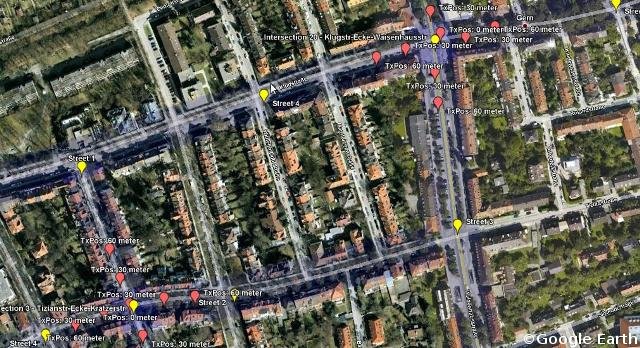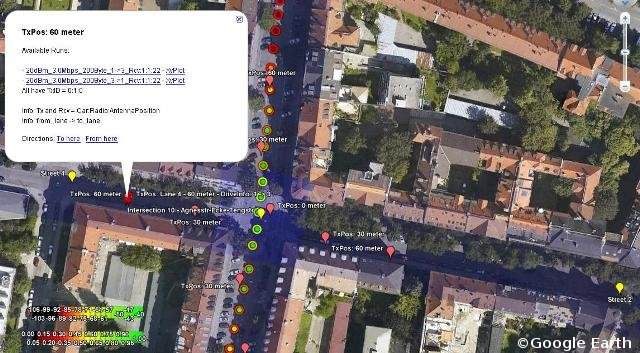Real-World Measurements of Non-Line-Of-Sight Reception Quality
for 5.9 GHz IEEE 802.11p at Intersections
It appeared in Lecture Notes in Computer Science, Volume 6596/2011, Springer Berlin / Heidelberg
(from 3rd International Workshop on Communication Technologies for Vehicles (Nets4Cars-2011), Oberpfaffenhofen, Germany)
All presented results originate from an 5.9 GHz IEEE 802.11p NLOS reception test at 8 intersections in Munich, performed in Oct/Nov 2010. We tested 2-3 sender distances per side street (30 and 60 meter, sometimes also 100m), plus 1 position in the center. We performed 2 test runs for each transmitter position on the crossing street (one in each direction).
The results of all test runs are accessible via a single kmz file (compressed kml).
It must be downloaded and opened in Google Earth:
If you do not have Google Earth yet:
Here are two screenshots from Google Earth to explain the provided evaluation:

The start file contains all tested intersections. Placemarks visualize the intersection center, street numbers and sender positions. The blue color shows the street area of interest. If you hit the sender placemarks, a popup opens showing the test runs that have been driven with this sender postion. Two links are provided for each run: A visualization of each run in Google Earth, and the corresponding Reception Power/Rate over distance plot.

Just select one of the links and a second kml is loaded. It shows the average reception power (donut) and rate (dot) color coded for each second of the drive through. The color coding legend is provided in the kml. You can deselect the opened kml in the side pane on the left of the Google Earth window.
Regarding the XY_Plot links, it is advisable to configure Google Earth to open links in an external browser. This makes it easier to compare plots from different runs.
This research was executed by Thomas Mangel (and Matthias Michl) at BMW Group Research and Technology, in 2010/2011. Thanks for hosting goes to the Decentralized Systems and Network Services Research Group at the Karlsruhe Institute of Technology.
